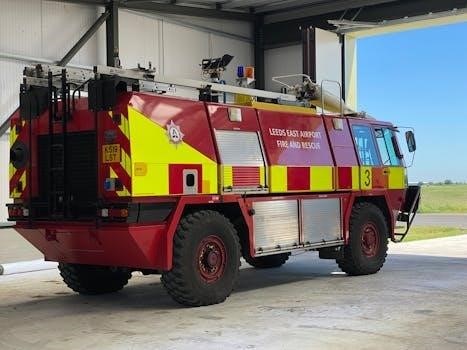
747 Bus Timetable Leeds Bradford Airport
The 747 bus service connects Bradford Interchange and Harrogate Bus Station, crucially stopping at Leeds Bradford Airport. For detailed schedules, consult Transdev’s Bus Open Data Service (BODS). Always check for updated timetables before traveling, especially during holidays.
Overview of the 747 Bus Service
The 747 bus service provides a crucial link between Bradford Interchange and Harrogate Bus Station, with a key stop at Leeds Bradford Airport (LBA). Operated by Transdev, this route is designed to serve passengers traveling to and from the airport, as well as commuters and residents along its path. The service aims to offer a convenient and accessible public transportation option, connecting major transport hubs and communities in West Yorkshire. The 747 route offers a vital transportation option for those seeking to travel between Bradford, Leeds Bradford Airport, and Harrogate. It provides a public transit solution for airport passengers as well as residents of the towns along the bus route. This service is a key component of the regional transportation network, enhancing connectivity and accessibility for both locals and travelers. The bus route’s schedule is constructed to provide regular and dependable service, though specific intervals may vary depending on time of day and day of the week. Passengers are encouraged to consult the most recent timetable information to plan their journeys accordingly. Furthermore, it’s important to note that the 747, like other bus services, can be subject to delays or alterations due to traffic conditions, road work, or unforeseen circumstances. Keeping up-to-date with live departure times and service alerts is crucial for seamless travel. Passengers can access real-time updates via the Transdev Go app, which offers information on bus locations and potential delays. This app is an invaluable tool for managing travel plans and staying informed about any disruptions that may arise. In summary, the 747 bus service is a vital public transportation link connecting Bradford, Leeds Bradford Airport, and Harrogate, providing a dependable and accessible travel option for passengers and residents. Checking the latest timetable and utilizing real-time updates are essential for a smooth journey.
747 Route⁚ Bradford Interchange to Harrogate
The 747 bus route is designed to connect Bradford Interchange with Harrogate, serving as a vital transportation link between these two key locations, with a significant stop at Leeds Bradford Airport (LBA) along the way. Starting at Bradford Interchange, a central transport hub in Bradford, the bus travels through several towns and villages before reaching the airport. From Bradford Interchange, the 747 bus route typically heads towards Greengates, Rawdon, and Yeadon before arriving at Leeds Bradford Airport. This section of the journey serves residential areas and commercial centers, making it a convenient option for local commuters and travelers. The stop at Leeds Bradford Airport is a crucial part of the route, providing access for passengers and airport employees alike. After leaving the airport, the 747 continues its journey towards Harrogate, passing through Pool, Weeton, and Pannal. These villages and towns benefit from the bus route’s connection to the airport and the larger urban centers of Bradford and Harrogate. The final destination is Harrogate Bus Station, another significant transport hub, offering onward connections to other destinations in the region. The entire route is designed to offer a comprehensive public transportation solution, serving a diverse range of passengers. The bus route not only offers a direct connection between Bradford and Harrogate but also provides essential links to Leeds Bradford Airport and the communities along the way. The route serves residents commuting to work or school, travelers heading to or from the airport, and visitors exploring the region. The 747 bus route is an integral part of the local transportation network, promoting accessibility and connectivity across West Yorkshire. Passengers planning to travel the 747 route are advised to consult the latest timetable information for precise departure times and stop locations. Real-time updates and journey planning tools can also help ensure a smooth and efficient journey. Furthermore, factors such as traffic conditions and road maintenance may affect travel times, so it is recommended to allow for potential delays when planning your trip.
Stops Along the 747 Route

The 747 bus route encompasses a variety of stops strategically placed to serve communities between Bradford Interchange and Harrogate. Beginning at Bradford Interchange, a major transportation hub, the route offers connections to numerous other bus and train services, facilitating onward travel for passengers. From Bradford Interchange, the 747 proceeds towards Greengates, a suburban area with a mix of residential and commercial properties. This stop caters to local residents and provides access to shops and services. The bus then continues to Rawdon, a village known for its historical buildings and scenic landscapes. The Rawdon stop serves both residents and visitors exploring the area’s heritage. Next, the 747 arrives in Yeadon, a town located close to Leeds Bradford Airport. This stop is essential for those traveling to and from the town or connecting to the airport. A key stop on the route is Leeds Bradford Airport itself, offering direct access for passengers, airport staff, and visitors. This stop is vital for regional connectivity and international travel. After departing the airport, the 747 heads towards Pool-in-Wharfedale, a picturesque village located in the Wharfedale valley. The Pool stop serves the local community and provides access to nearby attractions. The route then continues to Weeton, a village with a rural character and a strong sense of community. The Weeton stop is important for connecting residents to larger towns and cities. Next, the 747 stops at Pannal, a village known for its beautiful countryside and historic church. The Pannal stop serves the local population and provides access to recreational areas. The final stop is Harrogate Bus Station, another major transportation hub offering connections to various destinations. This stop is crucial for those traveling to and from Harrogate and the surrounding areas. Each stop along the 747 route is carefully positioned to serve the needs of the local communities and provide convenient access to key destinations. The route supports commuters, travelers, and visitors, enhancing connectivity and accessibility across the region. Passengers are advised to consult the latest timetable information for specific stop locations and departure times. Real-time updates and journey planning tools can also assist in ensuring a smooth and efficient travel experience.
Connecting to Leeds Bradford Airport
The 747 bus service provides a crucial link for passengers aiming to connect to Leeds Bradford Airport (LBA). This service is particularly beneficial for travelers coming from or heading towards Bradford and Harrogate, offering a direct and convenient transportation option. Passengers arriving at Leeds Bradford Airport can easily access the 747 bus from the terminal front, where the bus stop is conveniently located. This accessibility ensures a seamless transition for those continuing their journey towards Bradford, Greengates, Rawdon, Yeadon, Pool-in-Wharfedale, Weeton, Pannal, or Harrogate. The 747 bus service is also an excellent choice for individuals residing in these areas who need to reach the airport for flights or to pick up arriving passengers. By utilizing the 747, travelers can avoid the complexities and costs associated with driving and parking at the airport. The bus route’s strategic stops offer convenient access points throughout the region, making it a practical solution for many. Moreover, the 747 bus service complements other transportation options available at Leeds Bradford Airport. While the A1 Flyer service provides a direct link to Leeds city center and the 757 Flying Tiger bus connects to Leeds train station, the 747 offers a valuable alternative for those traveling to or from the north and west of the airport. For seamless connections, passengers should consult the latest timetable information for the 747 bus. This will ensure they are aware of departure times and can plan their journey accordingly. Real-time updates and journey planning tools, such as the Transdev Go app, can also be utilized to track the bus’s location and receive notifications of any delays or disruptions. In addition to the 747 bus, Leeds Bradford Airport is also served by other bus routes, including the A2 Flyer, which connects Harrogate and Bradford to the airport. By understanding the various bus services available, passengers can choose the most suitable option based on their origin, destination, and travel preferences. Ultimately, the 747 bus service plays a vital role in enhancing connectivity to Leeds Bradford Airport, providing a convenient and reliable transportation solution for passengers traveling from across the region.

Alternative Bus Services⁚ 737 and A1/A2 Flyer
In addition to the 747 bus service, Leeds Bradford Airport (LBA) is well-served by a range of alternative bus routes, offering passengers diverse options for reaching their desired destinations. Among these, the 737 bus and the A1/A2 Flyer services stand out as prominent alternatives. The 737 bus route provides a connection between Bradford, Shipley, Esholt, Guiseley, Yeadon, and Leeds Bradford Airport. This service is particularly useful for passengers traveling from or to these specific areas, offering a direct and convenient mode of transportation. The 737 route complements the 747 by serving communities that may not be directly on the 747’s path, expanding the airport’s accessibility to a wider geographical area. The A1 Flyer service operates between Leeds Bradford Airport and Leeds city center, providing a frequent and direct link for passengers traveling to or from the city. With buses running every 30 minutes, the A1 Flyer offers a convenient option for those seeking a quick and reliable transfer between the airport and Leeds. The A1 service starts from stop F7 on New York Street in Leeds, making it easily accessible from various points within the city. The A2 Flyer service, on the other hand, connects Harrogate and Bradford to Leeds Bradford Airport. Operating on an hourly frequency, the A2 Flyer provides a valuable transportation option for passengers traveling from these towns. The A2 route serves various locations along its path, including Greengates and Apperley Bridge, further enhancing its accessibility to the region. When choosing between these alternative bus services, passengers should consider their origin, destination, and travel preferences. The 737 is ideal for those traveling from specific towns along its route, while the A1 Flyer is the best choice for direct access to Leeds city center. The A2 Flyer caters to passengers traveling from Harrogate or Bradford. By understanding the distinct routes and schedules of these bus services, passengers can make informed decisions and select the most suitable option for their journey. To ensure a smooth and seamless transfer, it is always recommended to check the latest timetable information and real-time updates for these services. This will help passengers stay informed of any potential delays or disruptions and plan their travel accordingly. These alternative bus services, in conjunction with the 747, contribute to a comprehensive transportation network that effectively connects Leeds Bradford Airport to the surrounding region.
757 Flying Tiger Bus Service to Leeds
The 757 Flying Tiger bus service provides a crucial link between Leeds Bradford Airport (LBA) and Leeds city center, offering a convenient and efficient transportation option for travelers. This service is particularly popular due to its direct route and frequent departures, making it an attractive alternative to taxis or private transportation. The 757 bus route connects the airport directly to Leeds train station, a major transportation hub in the city. This connection is invaluable for passengers arriving at LBA who need to connect to onward train services to other destinations. Similarly, it provides a seamless transfer for travelers arriving in Leeds by train and needing to reach the airport for their flights. The journey time on the 757 Flying Tiger bus is approximately 30 minutes, making it a relatively quick and efficient way to travel between the airport and the city center. The buses operate frequently, with departures every 30 minutes, ensuring minimal waiting time for passengers. The service runs seven days a week, from Monday to Sunday, providing consistent transportation options for travelers regardless of the day of the week. The operational hours of the 757 bus service are designed to accommodate a wide range of flight schedules. Buses start running from just before 6⁚00 AM and continue until just after midnight, catering to early morning and late-night flights. This extended service window ensures that passengers arriving or departing at various times of the day have access to reliable transportation. The 757 Flying Tiger buses are equipped with amenities designed to enhance the passenger experience. These include free Wi-Fi, allowing passengers to stay connected and productive during their journey, and power outlets, enabling them to charge their electronic devices. These features contribute to a comfortable and convenient travel experience. To locate the 757 bus stop at Leeds Bradford Airport, passengers should head to the terminal front, where the airport’s bus stop is situated; This designated area provides clear signage and information about the various bus services operating from the airport, including the 757 Flying Tiger. Similarly, in Leeds city center, the 757 bus departs from a designated stand at the train station, making it easy for passengers to find the correct departure point. For those planning their journey, it is always recommended to check the latest timetable information for the 757 Flying Tiger bus service. This will ensure that passengers have the most up-to-date information on departure times and any potential service disruptions. Real-time updates and journey planning tools are also available online, allowing passengers to track the bus’s progress and estimate their arrival time. By utilizing the 757 Flying Tiger bus service, travelers can enjoy a hassle-free and cost-effective transfer between Leeds Bradford Airport and Leeds city center, making it an integral part of the airport’s transportation network.

Impact of Weather on Bus Services

Timetable Availability and Changes
Accessing the most current timetable for the 747 bus service, which connects Bradford Interchange to Harrogate and serves Leeds Bradford Airport, is crucial for effective journey planning; Due to the dynamic nature of transportation schedules, relying on outdated information can lead to missed connections and travel disruptions. To ensure accuracy, passengers should always consult the official sources for the latest timetable details. The primary source for timetable information is usually the website of the bus operator, typically Transdev, which runs the 747 service. These websites are regularly updated with the most current schedules, including any temporary or permanent changes to the route or timings. In addition to the operator’s website, real-time journey planning tools and apps, such as those provided by West Yorkshire Metro (wymetro.com), can be invaluable. These platforms often integrate live data feeds, providing up-to-the-minute information on bus locations and estimated arrival times. This feature is particularly helpful for tracking the bus’s progress and anticipating any potential delays. It’s important to be aware that bus timetables are subject to change for a variety of reasons. These changes can be temporary, such as those implemented during roadworks or special events, or they can be permanent, reflecting adjustments to service demand or operational efficiency. Common reasons for timetable modifications include seasonal adjustments, where schedules are altered to reflect changes in passenger traffic during peak and off-peak seasons. Public holidays often result in reduced service frequencies, with buses operating on a Sunday or Bank Holiday timetable. Infrastructure work, such as road closures or bridge repairs, can necessitate temporary route diversions and timetable adjustments. Unexpected events, such as severe weather conditions or traffic incidents, can also cause delays and disruptions to bus services. To stay informed about potential timetable changes, passengers should regularly check the operator’s website or social media channels for announcements. Many bus operators use social media platforms like Twitter and Facebook to provide real-time updates on service disruptions and timetable alterations. Subscribing to email alerts or SMS notifications from the operator can also be an effective way to receive timely updates. When planning a journey, it’s always advisable to factor in extra time for potential delays, especially during peak hours or in adverse weather conditions. Checking the weather forecast and traffic reports can help anticipate potential disruptions and allow for alternative travel arrangements if necessary. By proactively monitoring timetable information and staying informed about potential changes, passengers can minimize the risk of travel disruptions and ensure a smoother and more reliable journey on the 747 bus service.